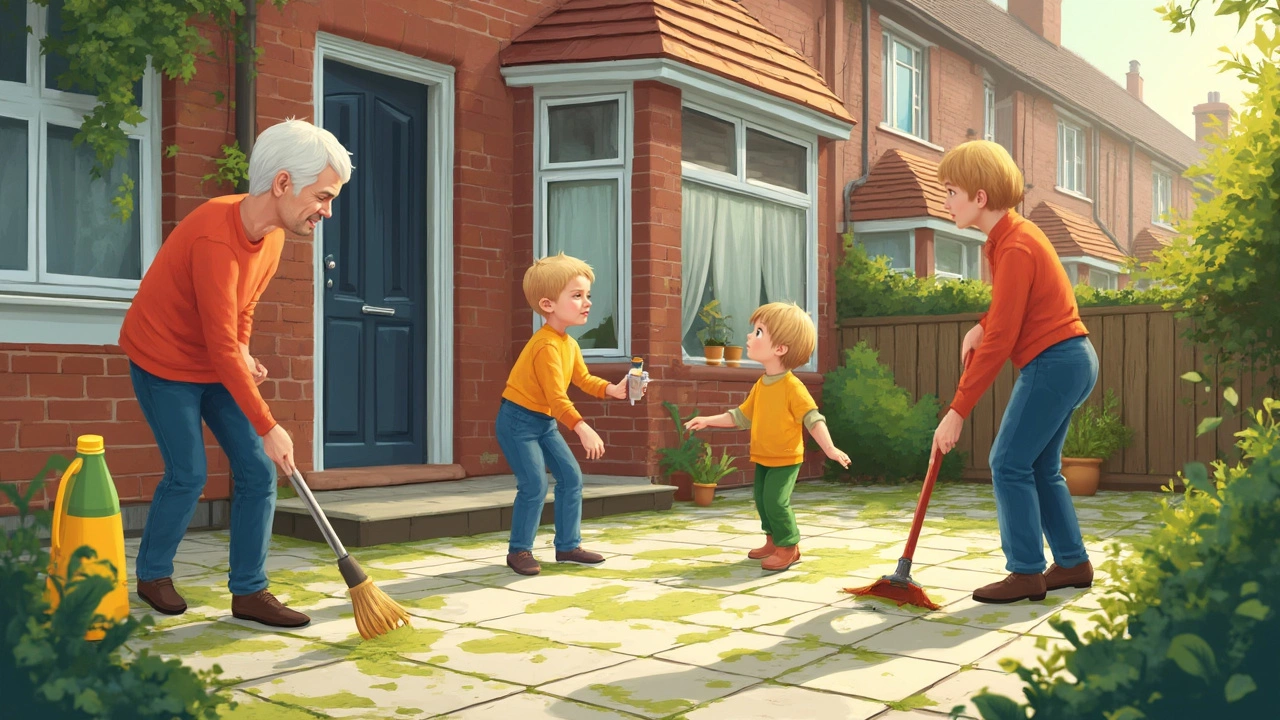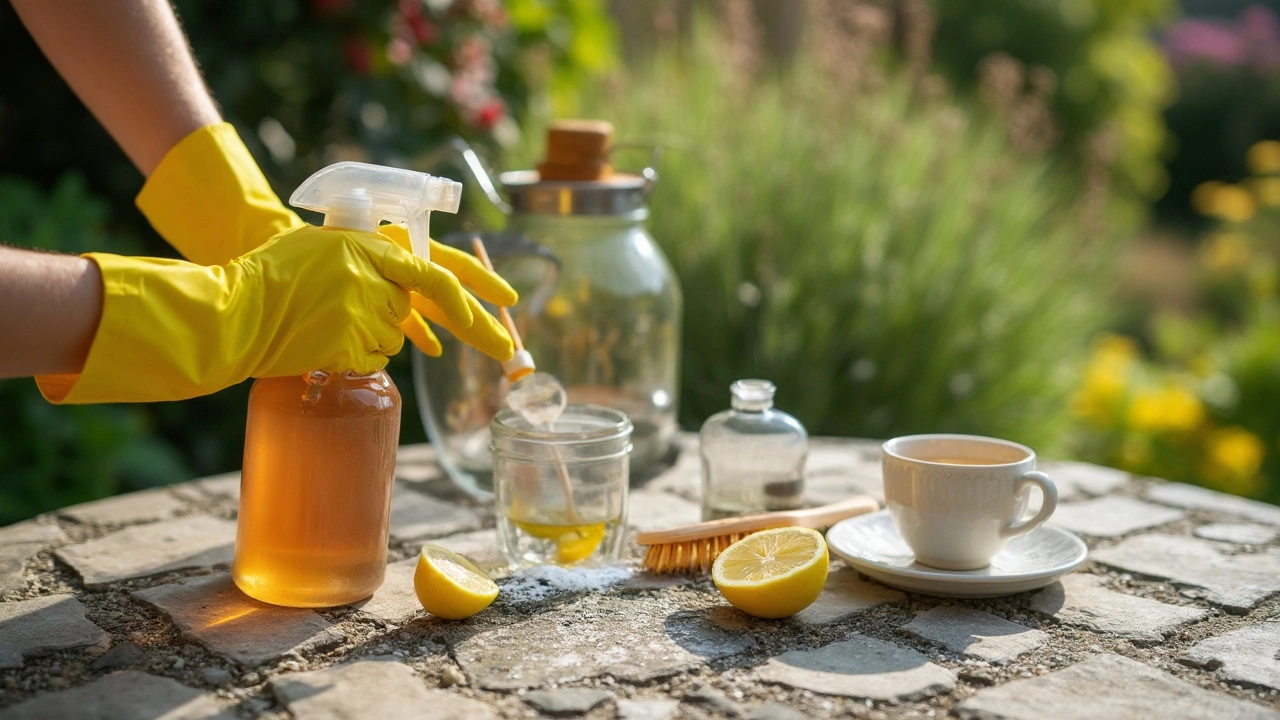Mold on your patio is more than an eyesore—it’s a total mood killer if you like backyard hangouts. The stuff loves damp spots, especially on shady concrete or right under your cozy outdoor chairs. Maybe you’ve tried scrubbing, but it keeps showing up? Mold spores are stubborn and can live almost anywhere that stays moist.
Turns out, you don’t always need fancy chemicals to get rid of mold. Good old white vinegar, hydrogen peroxide, bleach, and even baking soda can do the job if you use them right. Each has an edge—like vinegar killing about 80% of mold species and hydrogen peroxide fizzing away the rest. Just don’t mix these cleaners; pick one and stick with it to steer clear of weird reactions or toxic fumes.
- Why Patio Mold Grows Fast
- Best Mold Killers You Can Use
- Doing the Cleanup: What Really Works
- How to Keep Mold Away for Good
Why Patio Mold Grows Fast
If you keep seeing patches of mold on your patio, you’re not imagining things. Mold removal feels like a never-ending job mostly because patios have the perfect recipe for a mold party. Mold spores are always hanging around in the air, but they need just a few things to go wild: moisture, shade, and something to grow on—like your favorite outdoor furniture or even the concrete itself.
Patios usually get less sun because of trees, awnings, or backyard fences, which means they stay damp way longer than open areas. Even small puddles from rain or a leaky hose can do the trick. Once things are a bit damp, mold finds a home fast, sometimes growing in less than 48 hours if the weather’s right. Here’s what makes the problem worse:
- Shade and Poor Airflow: Covered patios or those blocked by fences don’t dry out easily, giving mold a constant spot to thrive.
- Organic Debris: Leaves, dirt, or pollen sitting on surfaces? That’s mold’s starter pack for breakfast. Clean it off and you’ll see less growth.
- Porous Materials: Concrete, wood, and outdoor cushions suck up and hold water. Mold loves these materials the most compared to smoother plastics or metals.
In fact, a recent homeowner survey found that patios next to trees or high fences had mold problems 30% more often than those out in the open. You can’t completely block spores from landing, but if the area’s always damp, you’re basically giving them an open invite. Understanding what molds need is your first win—they can’t take over if they can’t get comfy in the first place.
Best Mold Killers You Can Use
If you’re dealing with mold removal on the patio, you probably want something that kills it fast and keeps it gone for a while. Here’s the good news: you probably have most of what you need in your kitchen or garage. Let’s look at what really works, why, and how to use each option the right way.
- White Vinegar: This is hands-down a favorite for a reason. White vinegar (straight, not diluted) kills about 80% of known mold species. Pour it in a spray bottle, coat the affected spots, and let it sit for at least an hour before scrubbing. Don't rinse off unless the smell bothers you; the longer it lingers, the more spores it kills.
- Bleach: Great at killing surface mold on hard, non-porous areas like concrete—but not as deep-penetrating as you might think. Mix one cup of bleach to a gallon of water, scrub it on, then rinse well. Avoid mixing bleach with other cleaners, especially vinegar or ammonia, as that combo can let off dangerous fumes.
- Hydrogen Peroxide (3%): This is budget-friendly and strong against mold. Spray peroxide on affected areas and let it bubble for 10-15 minutes before cleaning off. Unlike bleach, hydrogen peroxide also attacks deeper into porous spots like patio pavers or grout lines.
- Baking Soda: Not just for the fridge—baking soda is a safe mold cleaner for families and pets. Mix a tablespoon with warm water in a spray bottle, spritz the area, scrub, and leave a light coating behind as a preventive step.
If you want to see how these options stack up, check out this quick rundown:
| Mold Killer | Best For | Porous Surfaces? | Pet Safe |
|---|---|---|---|
| White Vinegar | General cleaning | Yes | Yes |
| Bleach | Concrete, Stone | No | No |
| Hydrogen Peroxide | Pavers, grout | Yes | Yes |
| Baking Soda | Mild outbreaks | Yes | Yes |
One last thing: you don’t need commercial cleaners unless things are really bad. Most patio cleaning products at the store are just stronger versions of these basics—plus extra chemicals. For regular outdoor furniture mold, any of these simple options get the job done.

Doing the Cleanup: What Really Works
Time to get hands-on. If you’re tired of seeing fuzzy green or black patches, here’s how you actually kill mold on your patio—and keep it from waving hello again.
The first thing: gear up. Mold’s not just gross, it’s rough on your lungs too. Slip on gloves and a mask, especially if you’re using stuff like bleach. Old clothes are a good idea because these products can stain.
Start by sweeping your outdoor furniture and the patio. Get rid of leaves and dirt so the cleaner can hit the mold right where it grows.
- Vinegar Method
Pour straight white vinegar into a spray bottle—no need to dilute. Soak the moldy spots and let it sit for one hour. Scrub with a stiff brush, then rinse with a hose. Easy and safe for most patios. - Bleach Solution
Mix 1 cup of bleach with a gallon of water in a bucket. Scrub the spots well and rinse off. Bleach can handle tough cases, but don’t use it on colored or delicate patio surfaces—fading can happen fast. - Hydrogen Peroxide
Pour 3% peroxide straight on the mold and let it bubble for about 10 minutes. Scrub and rinse. This is less harsh than bleach and won’t leave a strong smell behind. - Baking Soda Boost
If you want a gentle scrub, mix 2 tablespoons of baking soda with water until it’s a paste. Smear, scrub, rinse—done. This option is safe for pets and kids rolling around outside.
One pro tip: Never mix bleach and vinegar or peroxide. The fumes can be dangerous—keep it simple and use one product at a time.
If you’re into stats, here’s why folks love vinegar and bleach for mold removal:
| Cleaner | Elimination Rate |
|---|---|
| White Vinegar | Up to 80% |
| Bleach | 99% (surface mold) |
| Hydrogen Peroxide | Up to 90% |
Outdoor expert Jack Hawkins puts it plainly:
"Vinegar and bleach both work, but picking the right one depends on your patio surface. Vinegar is better for stone, while bleach is best for plain concrete."
Once you’re done, keep the area dry as much as possible. The less moisture, the less mold. And if you spot a little patch coming back, jump on it early—don’t give it a second chance.
How to Keep Mold Away for Good
After you’ve nuked mold from your patio, the next move is making sure it doesn’t make a comeback. Mold removal is only half the battle—keeping the space dry and well-ventilated is what really counts. Mold hates sunlight, so the more you let the rays hit your patio, the better. Trim back any bushes or tree limbs that keep the area in shade for most of the day.
Moisture is mold’s best friend. If your patio pools water every time it rains, figure out a fix. Sometimes just tilting things for better drainage works. Check gutters nearby and clear them out so water doesn’t dump right onto your outdoor furniture or concrete. Got leaks or dripping hoses? Fix them, or you’ll be in the same boat next season.
- Move outdoor furniture often, so water doesn’t get trapped under legs or covers.
- Use a mildew-resistant sealant on patios, decks, and even furniture, especially if it’s wood or concrete.
- Spray down surfaces with a vinegar solution (one part vinegar, one part water) once a month as an easy mold buster.
- Keep patio cushions and rugs dry by storing them inside or in a water-resistant box during wet months.
If you want to go all out, consider installing a small fan for airflow or use dehumidifier granules for covered patios. These tricks work wonders in areas where humidity is off the charts—think the Southeast or anywhere mold grows on repeat during spring and summer.
| Strategy | How Often | Why It Works |
|---|---|---|
| Trim vegetation | Every few months | Boosts sunlight, cuts moisture |
| Seal patio surfaces | Once a year | Blocks water from seeping in |
| Regular vinegar spray | Monthly | Kills mold spores before they spread |
| Move furniture | After rain | Prevents trapped humidity |
Staying ahead of mold means not letting your guard down, even after a deep clean. Make these habits part of your regular patio routine and your patio cleaning days will get a whole lot easier.


Write a comment